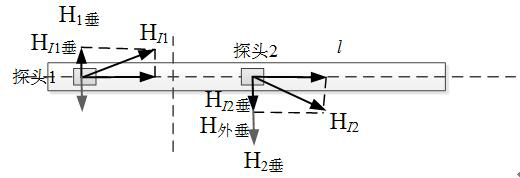A Method for Detecting AC and DC Stray Currents in Buried Pipelines
A stray current and buried pipeline technology, applied in the field of detection, can solve the problems of electromagnetic field error, unknown distance between the magnetometer probe and the pipeline, and the inability to accurately and effectively detect the magnetic field
- Summary
- Abstract
- Description
- Claims
- Application Information
AI Technical Summary
Problems solved by technology
Method used
Image
Examples
Embodiment 1
[0066] The present invention provides a buried pipeline AC and DC stray current detection method,
[0067] S1. Select the position of the buried pipeline to be detected;
[0068] S2. Arranging the three magnetometer probes in a horizontal array at equal intervals on the surface where the buried pipeline is located; the three probes are probe one, probe two and probe three in sequence;
[0069] S3. When there are AC and DC stray currents in the pipeline, probe 1, probe 2, and probe 3 respectively detect the magnetic fields at their respective positions;
[0070] S4, according to the result of S3 detection, obtain the vertical component size of external stable magnetic field interference, eliminate the vertical component influence of external stable magnetic field interference;
[0071] S5. Calculate the buried depth of the pipeline according to the results of S3 and S4;
[0072] S6. Obtain the current of the pipeline under the magnetometer probe array according to the buried ...
Embodiment 2
[0077] see figure 1 and figure 2 , On the basis of Example 1, three magnetic saturation magnetometer probes are arranged horizontally to form an array, the distance between the three magnetic saturation magnetometer probes is 1, and a three-component magnetic saturation magnetometer probe is selected. When detecting the AC and DC stray current of the pipeline, the buried d of the pipeline is unknown, and when the probe array is placed, the pipeline is located on the central axis of probe 1 and probe 2. When there is AC / DC stray current I in the pipeline, probe 1, probe 2, and probe 3 will all detect the magnetic fields at their respective positions, but the detected magnetic fields are disturbed by external stable magnetic fields (such as geomagnetism or other stable magnetic fields). At this time, the electromagnetic field detected by the probe cannot be directly used to calculate the pipeline current, but the influence of other stable magnetic field interference should be ...
PUM
 Login to View More
Login to View More Abstract
Description
Claims
Application Information
 Login to View More
Login to View More - R&D
- Intellectual Property
- Life Sciences
- Materials
- Tech Scout
- Unparalleled Data Quality
- Higher Quality Content
- 60% Fewer Hallucinations
Browse by: Latest US Patents, China's latest patents, Technical Efficacy Thesaurus, Application Domain, Technology Topic, Popular Technical Reports.
© 2025 PatSnap. All rights reserved.Legal|Privacy policy|Modern Slavery Act Transparency Statement|Sitemap|About US| Contact US: help@patsnap.com



